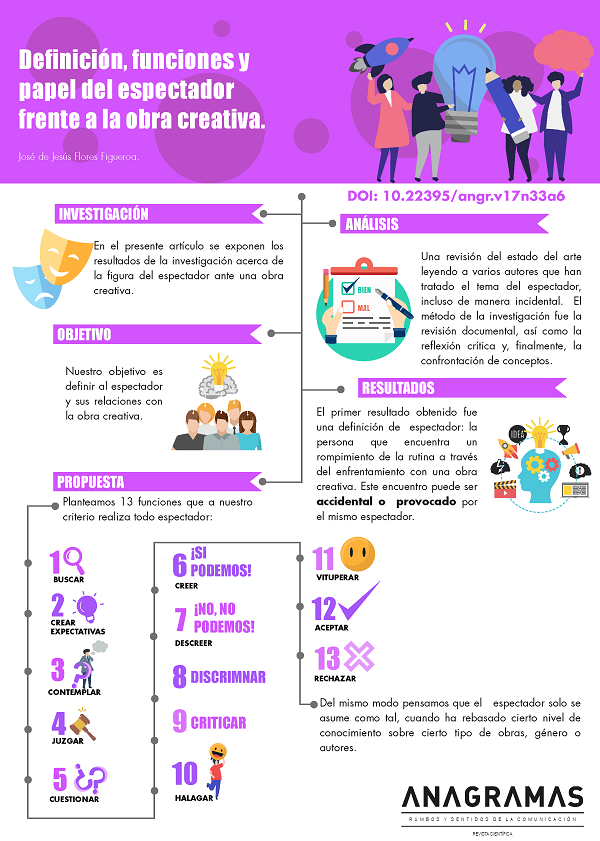
Definición, funciones y papel del espectador frente a la obra creativa
Derechos de autor 2023 Anagramas Rumbos y Sentidos de la Comunicación

Esta obra está bajo licencia internacional Creative Commons Reconocimiento-NoComercial-SinObrasDerivadas 4.0.
- Articles
-
Publicado: diciembre 31, 2018
Resumen
En el presente artículo se exponen los resultados de la investigación acerca de la figura del espectador ante una obra creativa. Se hizo una revisión del estado del arte leyendo a varios autores que han tratado el tema del espectador, incluso de manera incidental. Este primer análisis nos llevó a pensar que no hay suficientes intentos para definir, ni al espectador ni su campo de acción cuando interactúa con un trabajo creativo. Como consecuencia, creemos que no hay bastante literatura científica actualizada sobre el concepto específico de espectador. Así nuestro objetivo es definir al espectador y sus relaciones con la obra creativa.
El método de la investigación fue la revisión documental, así como la reflexión crítica y, finalmente, la confrontación de conceptos. El primer resultado obtenido fue una definición de espectador: la persona que encuentra un rompimiento de la rutina a través del enfrentamiento con una obra creativa. Este encuentro puede ser accidental o provocado por el mismo espectador. De este contacto con la obra, es imprescindible que la persona interactúe con esta expresión. Asimismo, derivados de dicha propuesta, la persona puede obtener estímulos lúdicos, estéticos o culturales. Del mismo modo, planteamos 13 funciones que a nuestro criterio realiza todo espectador: 1. Buscar, 2. Crear expectativas, 3. Contemplar, 4. Juzgar, 5. Cuestionar 6. Creer 7. Descreer, 8. Discriminar, 9. Criticar, 10. Halagar, 11. Vituperar, 12. Aceptar, 13. Rechazar. Del mismo modo pensamos que el espectador solo se asume como tal, cuando ha rebasado cierto nivel de conocimiento sobre cierto tipo de obras, género o autores.
Referencias
Alcolea, J. (2009). Visual Arguments in Film. Argumentation, 23(2), 259–275.
Andersen, K. (2005). Harry Potter and the Susceptible Child Audience. CLCWeb, 7(2), 2-10.
Aumont, J. (1992). La imagen. Madrid, España: Paidós.
Babatunde, B. y Simmons, R. (2007). A tale of two audiences: spectators, television viewers and outcome uncertainty in Spanish football. Journal of economics and business, 61(4), 326-338.
Cerezo Arriaza, M. (1996). La televisión: del espectador ingenuo al espectador crítico. Revista Comunicar, (6), 15-21.
Chabot, K. (2008). Audience, Sentimental Postmodernism, and Kiss of the Spider Woman. CLCWeb: Comparative Literature and Culture, 10(3).
Contreras, F. y Gasca, L. (2016). Las emociones del espectador en una experiencia fotográfica, pictórica y cinematográfica. Praxis y Saber, 7(14), 165-192.
De Souza Barros, M. (2015). Luzes sobre o Espectador: artistas e docentes em ação. Rev. Bras. Estud. Presença, 5(2), 330-355.
Díaz, V. (2012). Espectadores de falsos documentales. Los falsos documentales en la sociedad de la información. Athenea Digital, 12(3), 153-162.
Kirkkopelto, E. (2011). I am a Child. Hypothesis on Spectator Pedagogy. Ethics in Progress Quarterly (ethicsinprogress.org), 2(2), 81-87.
Happer, C. y Philo, G. (2013). The role of the media in the construction of public belief and social change. Journal of Social and Political Psychology, 1(1), 321-336.
Heddon, D., Iball, H., y Zerihan, R. (2012). Come closer: confessions of intimate spectators in one to one performance. Contemporary Theatre Review, 22 (1). 121-134.
Hernández, B. y Martín, J.L. (1998). La recepción de la obra de arte y la participación del espectador en las propuestas artísticas contemporáneas. Revista Española de Investigaciones Sociológicas, (84), 45-63.
Lauwrens, J. (2012). Can you see what I mean? An exploration of the limits of vision in anti-ocularcentric contemporary art. De arte, (85), 26-41.
Liebers, N. y Schramm, H. (2017). Friends in books: The influence of character attributes and the reading experience on parasocial relationships and romances. Poetics, 65, 12-23.
Loscertales, F. y Núñez, T. (2008). Ver cine en TV: una ventana a la socialización familiar. Comunicar, XVI(31), 137-143.
Lopes, F. y Loureiro, L. (2011). My Newscast Is No Longer Ours. Journalism and Mass Communication, 1(3), 201-212.
Massara, G., Sabeckis, C. y Vallazza, E. (2018). Tendencias en el cine expandido contemporáneo. Cuadernos del centro de estudios en diseño y comunicación. Ensayos, (66), 157-172.
Moreno, M. (2006). Educar espectadores: propuestas expositivas y dinamización. Comunicar, (28), 211-228.
Niven, Larry. (1987). Los ingenieros del mundo anillo. Ciudad de México: Ediciones Roca, S.A.
O’Neill, B. (2006). Experiences of interaction and participation in media communication in a digital environment. IAMCR Annual Congress, El Cairo, Egipto
O’Neill, B., Gallego, J. I. y Zeller, F. (2013). New perspectives on audience activity: ‘prosumption’ and media activism as audience practices. En N. Carpentier, K. Schrøder. y L. Hallett (eds.), Audience Transformations: Shifting Audience Positions in Late Modernity (pp.157-171). Londres: Routledge.
Ortega y Gasset, J. (1985). El espectador. Madrid: Alianza Editorial
Pimentel, L. A. (2010). El relato en perspectiva. Estudio de teoría narrativa. Ciudad de México: Siglo XXI Editores.
Prósper, J. (2013). El sistema de continuidad: montaje y causalidad. Historia y Comunicación Social, 18(1), 377-386.
Rincón, O. (2008). No más audiencias, todos devenimos en productores. Comunicar, 15(30), 93-98.
Roldán, C. (2010). El actor y el espectador. De freud a Lacan. Revista Affectio Societatis, 7(13).
Sánchez‐Escalonilla, A. (2013). Verisimilitude and Film Story: the links between Screenwriter, Character and Spectator. Comunication & Society, 26(2), 79‐94.
Scott, S. (2017). Modeling the Marvel everyfan: Agent Coulson and/as transmedia fanculture. Palabra Clave, 20(4), 1042-1072. DOI: 10.5294/pacla.2017.20.4.8.
Torrente, P. (2015). La sutura de lo ausente. El espectador como actor en el videoarte. Cuaderno, 52,19-29.




























